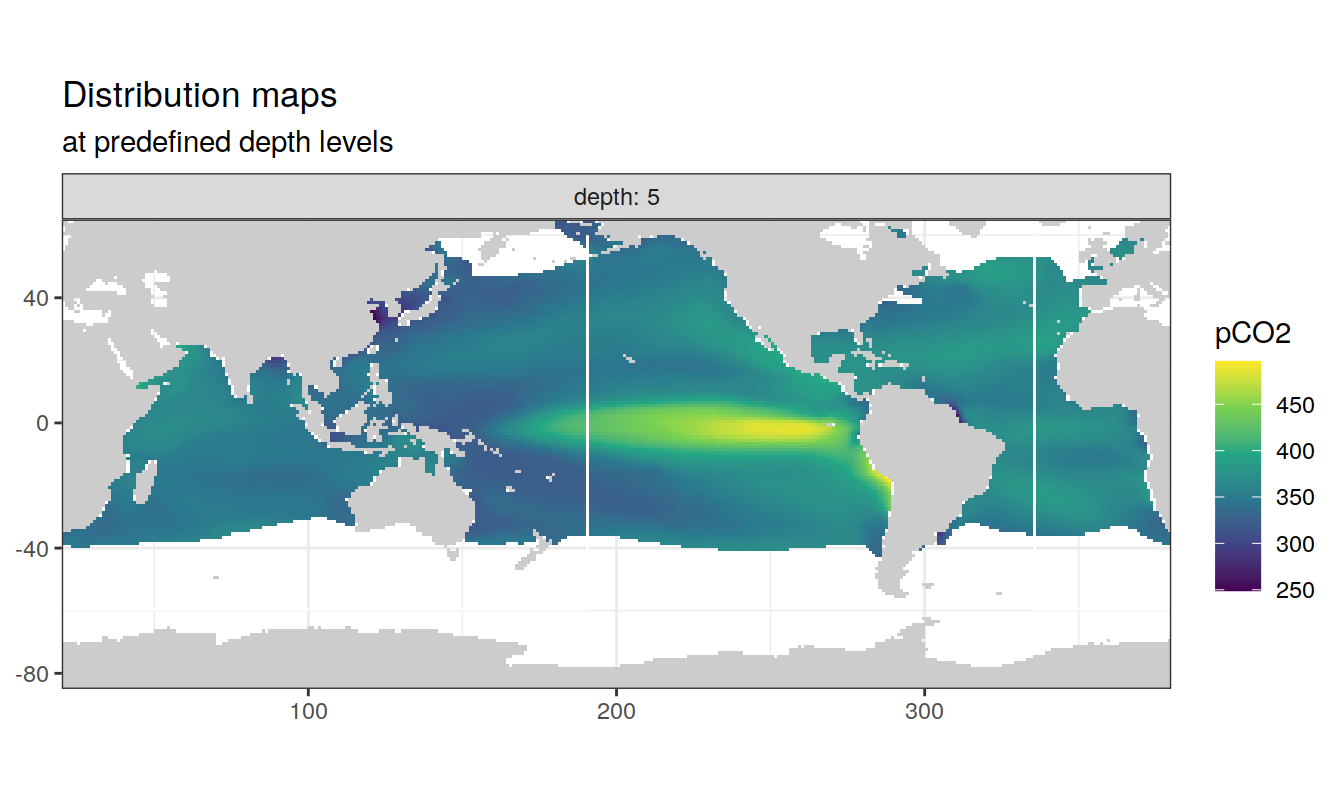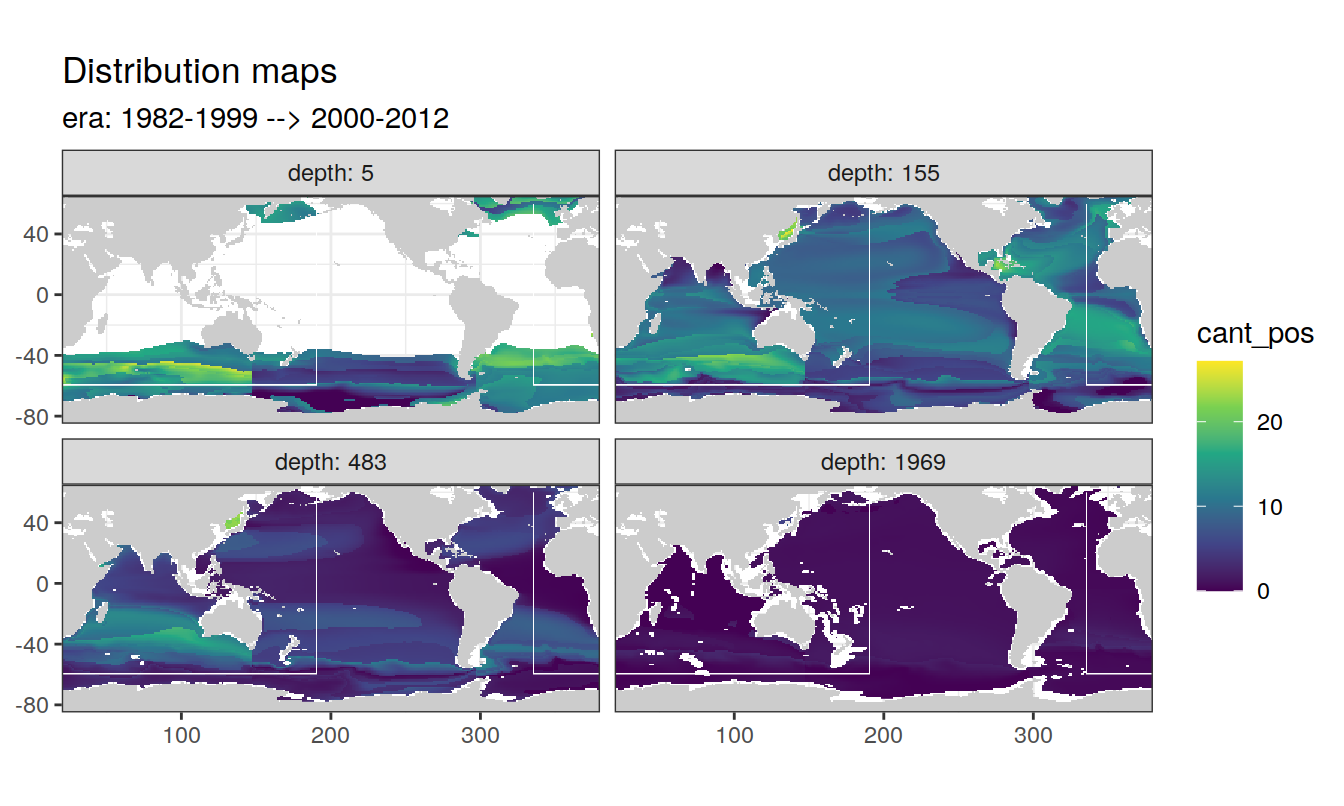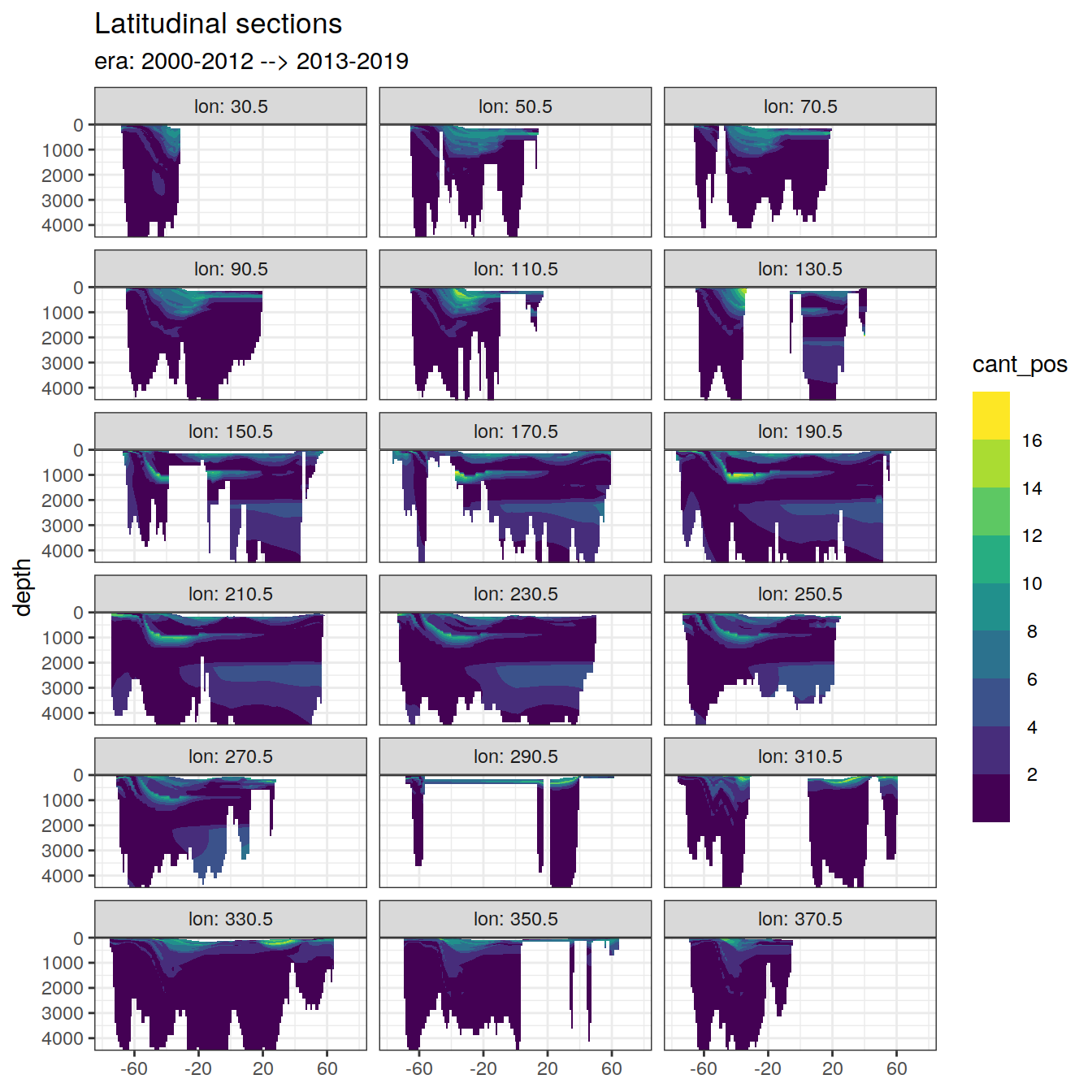Mapping cant
Jens Daniel Müller
21 December, 2020
Last updated: 2020-12-21
Checks: 7 0
Knit directory: emlr_mod_v_XXX/
This reproducible R Markdown analysis was created with workflowr (version 1.6.2). The Checks tab describes the reproducibility checks that were applied when the results were created. The Past versions tab lists the development history.
Great! Since the R Markdown file has been committed to the Git repository, you know the exact version of the code that produced these results.
Great job! The global environment was empty. Objects defined in the global environment can affect the analysis in your R Markdown file in unknown ways. For reproduciblity it’s best to always run the code in an empty environment.
The command set.seed(20200707) was run prior to running the code in the R Markdown file. Setting a seed ensures that any results that rely on randomness, e.g. subsampling or permutations, are reproducible.
Great job! Recording the operating system, R version, and package versions is critical for reproducibility.
Nice! There were no cached chunks for this analysis, so you can be confident that you successfully produced the results during this run.
Great job! Using relative paths to the files within your workflowr project makes it easier to run your code on other machines.
Great! You are using Git for version control. Tracking code development and connecting the code version to the results is critical for reproducibility.
The results in this page were generated with repository version 00a1322. See the Past versions tab to see a history of the changes made to the R Markdown and HTML files.
Note that you need to be careful to ensure that all relevant files for the analysis have been committed to Git prior to generating the results (you can use wflow_publish or wflow_git_commit). workflowr only checks the R Markdown file, but you know if there are other scripts or data files that it depends on. Below is the status of the Git repository when the results were generated:
Ignored files:
Ignored: .Rproj.user/
Note that any generated files, e.g. HTML, png, CSS, etc., are not included in this status report because it is ok for generated content to have uncommitted changes.
These are the previous versions of the repository in which changes were made to the R Markdown (analysis/mapping_cant.Rmd) and HTML (docs/mapping_cant.html) files. If you’ve configured a remote Git repository (see ?wflow_git_remote), click on the hyperlinks in the table below to view the files as they were in that past version.
| File | Version | Author | Date | Message |
|---|---|---|---|---|
| Rmd | 00a1322 | Donghe-Zhu | 2020-12-21 | first build after creating model template |
| html | c8b76b3 | jens-daniel-mueller | 2020-12-19 | Build site. |
| Rmd | b5fedce | jens-daniel-mueller | 2020-12-19 | first build after creating model template |
| Rmd | 8e8abf5 | Jens Müller | 2020-12-18 | Initial commit |
1 Required data
1.1 Predictor fields
Currently, we use following combined predictor fields:
- WOA18: S, T, and derived variables
- GLODAP16: Oxygen, PO4, NO3, Silicate, and derived variables
predictors <-
read_csv(paste(path_version_data,
"W18_st_G16_opsn.csv",
sep = ""))
predictors_surface <-
read_csv(paste(path_version_data,
"W18_st_G16_opsn_surface.csv",
sep = ""))1.2 Atm. pCO2
Required only to estimate the change of Cant in surface water and assuming that the ocean pCO2 trend follows the atmospheric forcing.
co2_atm_tref <-
read_csv(paste(path_version_data,
"co2_atm_tref.csv",
sep = ""))1.3 MLR models
lm_best_cant <-
read_csv(paste(path_version_data,
"lm_best_cant.csv",
sep = ""))2 Join MLRs + climatologies
# remove predictor variable from model
lm_best_cant <- lm_best_cant %>%
mutate(model = str_remove(model, "Cstar ~ "))
# join predictors and MLR
cant <- full_join(predictors, lm_best_cant)
rm(predictors, lm_best_cant)3 Map Cant
3.1 Deep water
3.1.1 Apply MLRs to predictor
cant <- b_cant(cant)3.1.2 Sections by model
Zonal section plots are produced for every 20° longitude, each era and for all models individually. Plots can be accessed here:
- /nfs/kryo/work/jenmueller/emlr_cant/model/v_XXX/figures/Cant_model_sections/
if (params_local$plot_all_figures == "y") {
for (i_eras in unique(cant$eras)) {
# i_eras <- unique(cant$eras)[2]
cant_eras <- cant %>%
filter(eras == i_eras)
for (i_lon in params_global$longitude_sections_regular) {
# i_lon <- params_global$longitude_sections_regular[7]
cant_eras_lon <- cant_eras %>%
filter(lon == i_lon)
limits = max(abs(cant_eras_lon$cant)) * c(-1, 1)
cant_eras_lon %>%
ggplot(aes(lat, depth, z = cant)) +
stat_summary_2d(
fun = "mean",
na.rm = TRUE,
bins = 20,
col = "grey"
) +
scale_fill_scico(name = "Cant",
palette = "vik",
limit = limits) +
scale_y_reverse(limits = c(params_global$plotting_depth, NA)) +
scale_x_continuous(limits = c(-85, 85)) +
labs(title = paste(
"eras:",
i_eras,
"| lon:",
i_lon,
"|",
params_local$Version_ID
)) +
facet_wrap(~ model, ncol = 5)
ggsave(
paste(
path_version_figures,
"Cant_model_sections/",
paste("Cant_model",
i_eras,
"lon",
i_lon,
"section.png",
sep = "_"),
sep = ""
),
width = 17,
height = 9
)
}
}
}3.2 Surface water
As outlined in Gruber et al. (2019), a transient equilibrium approach was applied to estimate Cant in surface waters, assuming that the CO2 system in these waters has followed the increase in atmospheric CO2 closely.
Using eq 10.2.16 from OBD, the change in anthropogenic CO2 in the upper ocean was computed as:
\(\Delta\)tCant,eq(t2 − t1) = 1∕\(\gamma\) ⋅ DIC/pCO2 ⋅ (pCO2,atm (t2)− pCO2,atm(t1))
, where DIC and pCO2 are the in situ values, where \(\gamma\) is the buffer (Revelle) factor and where we evaluated the right-hand side using seacarb employing the Luecker constants using the climatological values for temperature, salinity, DIC and Alk.
3.2.1 pCO2 climatology
Plots below show the calculated climatolofical pCO2 values.
# calculate pCO2 from talk and tco2 climatology
predictors_surface <- predictors_surface %>%
mutate(
pCO2 = carb(
flag = 15,
var1 = TAlk * 1e-6,
var2 = TCO2 * 1e-6,
S = sal,
T = temp,
P = depth / 10,
Pt = phosphate * 1e-6,
Sit = silicate * 1e-6,
k1k2 = "l"
)$pCO2
)p_map_climatology(df = predictors_surface,
var = "pCO2")
| Version | Author | Date |
|---|---|---|
| c8b76b3 | jens-daniel-mueller | 2020-12-19 |
p_section_climatology_regular(df = predictors_surface,
var = "pCO2",
surface = "y")
| Version | Author | Date |
|---|---|---|
| c8b76b3 | jens-daniel-mueller | 2020-12-19 |
3.2.2 Revelle factor
Plots below show the calculated climatolofical Revelle factor values.
predictors_surface <- predictors_surface %>%
mutate(
rev_fac = buffer(
flag = 15,
var1 = TAlk * 1e-6,
var2 = TCO2 * 1e-6,
S = sal,
T = temp,
P = depth / 10,
Pt = phosphate * 1e-6,
Sit = silicate * 1e-6,
k1k2 = "l"
)$BetaD
)p_map_climatology(df = predictors_surface,
var = "rev_fac")
| Version | Author | Date |
|---|---|---|
| c8b76b3 | jens-daniel-mueller | 2020-12-19 |
p_section_climatology_regular(df = predictors_surface,
var = "rev_fac",
surface = "y")
| Version | Author | Date |
|---|---|---|
| c8b76b3 | jens-daniel-mueller | 2020-12-19 |
3.2.3 Cant calculation
# calculate increase in atm pCO2 between eras
co2_atm_tref <- co2_atm_tref %>%
arrange(pCO2_tref) %>%
mutate(d_pCO2_tref = pCO2_tref - lag(pCO2_tref),
eras = paste(lag(era), era, sep = " --> ")) %>%
drop_na() %>%
select(eras, d_pCO2_tref)
cant_surface <- full_join(predictors_surface, co2_atm_tref,
by = character())
# calculate cant
cant_surface <- cant_surface %>%
mutate(cant = (1 / rev_fac) * (TCO2 / pCO2) * d_pCO2_tref)
# calculate positive cant
cant_surface <- cant_surface %>%
mutate(cant_pos = if_else(cant < 0, 0, cant))3.2.4 Control plots
# i_eras <- unique(cant_average$eras)[2]
for (i_eras in unique(cant_surface$eras)) {
print(
p_map_climatology(df = cant_surface %>% filter(eras == i_eras),
var = "cant") +
labs(subtitle = paste("era:", i_eras))
)
}
| Version | Author | Date |
|---|---|---|
| c8b76b3 | jens-daniel-mueller | 2020-12-19 |

| Version | Author | Date |
|---|---|---|
| c8b76b3 | jens-daniel-mueller | 2020-12-19 |
# i_eras <- unique(cant_surface$eras)[2]
for (i_eras in unique(cant_surface$eras)) {
print(
p_section_climatology_regular(df = cant_surface %>% filter(eras == i_eras),
var = "cant",
surface = "y") +
labs(subtitle = paste("era:", i_eras))
)
}
| Version | Author | Date |
|---|---|---|
| c8b76b3 | jens-daniel-mueller | 2020-12-19 |

| Version | Author | Date |
|---|---|---|
| c8b76b3 | jens-daniel-mueller | 2020-12-19 |
3.3 Average model Cant
Mean and sd are calculated across 10 models for Cant in each grid cell (XYZ), basin and era combination. Calculations are performed for all cant values vs positive values only.
3.3.1 Deep water averaging
cant_average <- m_cant_model_average(cant)
cant_average <- m_cut_gamma(cant_average, "gamma")
# split data set for individual predictor contributions and total cant
cant_predictor_average <- cant_average %>%
select(-c("cant", "cant_pos", ends_with("_sd")))
cant_average <- cant_average %>%
select(lon, lat, depth, eras, basin, basin_AIP,
cant, cant_pos, cant_sd, cant_pos_sd,
gamma, gamma_sd, gamma_slab)# i_eras <- unique(cant_average$eras)[2]
for (i_eras in unique(cant_surface$eras)) {
print(
p_map_climatology(
df = cant_average %>% filter(eras == i_eras),
var = "cant_pos",
subtitle_text = paste("era:", i_eras)
)
)
}
| Version | Author | Date |
|---|---|---|
| c8b76b3 | jens-daniel-mueller | 2020-12-19 |

| Version | Author | Date |
|---|---|---|
| c8b76b3 | jens-daniel-mueller | 2020-12-19 |
# i_eras <- unique(cant_surface$eras)[2]
for (i_eras in unique(cant_surface$eras)) {
print(
p_section_climatology_regular(
df = cant_average %>% filter(eras == i_eras),
var = "cant_pos",
subtitle_text = paste("era:", i_eras)
)
)
}
| Version | Author | Date |
|---|---|---|
| c8b76b3 | jens-daniel-mueller | 2020-12-19 |

| Version | Author | Date |
|---|---|---|
| c8b76b3 | jens-daniel-mueller | 2020-12-19 |
3.3.2 Surface water averaging
The averaging function is also applied to the surface data, although only one value per grid cell was mapped, to ensure consistency with the deep water values.
cant_surface_average <- m_cant_model_average(cant_surface)
cant_surface_average <- m_cut_gamma(cant_surface_average, "gamma")
rm(cant_surface)3.3.3 Join surface and deep water
cant_average <- full_join(cant_average, cant_surface_average)
rm(cant_surface_average)3.4 Zonal mean sections
For each basin and era combination, the zonal mean cant is calculated, again for all vs positive only values. Likewise, sd is calculated for the averaging of the mean basin fields.
cant_average_zonal <- m_cant_zonal_mean(cant_average)
cant_average_zonal <- m_cut_gamma(cant_average_zonal, "gamma_mean")3.5 Mean cant sections by coefficient
For each basin and era combination, the zonal mean is calculated for the term of each predictor.
cant_predictor_average_zonal <-
m_cant_predictor_zonal_mean(cant_predictor_average)
cant_predictor_average_zonal <-
m_cut_gamma(cant_predictor_average_zonal, "gamma")3.6 Inventory calculation
To calculate Cant column inventories, we:
- Convert Cant concentrations to volumetric units
- Multiply layer thickness with volumentric Cant concentration to get a layer inventory
- For each horizontal grid cell and era, sum cant layer inventories for different inventory depths (100, 500, 1000, 3000, 10^{4} m)
Step 2 is performed separately for all Cant and positive Cant values only.
cant_inv <- m_cant_inv(cant_average)
p_map_cant_inv(df = cant_inv,
var = "cant_pos_inv",
subtitle_text = "for predefined integration depths") +
facet_grid(inv_depth ~ eras)
| Version | Author | Date |
|---|---|---|
| c8b76b3 | jens-daniel-mueller | 2020-12-19 |
4 Write csv
cant_average %>%
write_csv(paste(path_version_data,
"cant_3d.csv", sep = ""))
cant_predictor_average %>%
write_csv(paste(path_version_data,
"cant_predictor_3d.csv", sep = ""))
cant_average_zonal %>%
write_csv(paste(path_version_data,
"cant_zonal.csv", sep = ""))
cant_predictor_average_zonal %>%
write_csv(paste(path_version_data,
"cant_predictor_zonal.csv", sep = ""))
cant_inv %>%
write_csv(paste(path_version_data,
"cant_inv.csv", sep = ""))
sessionInfo()R version 4.0.3 (2020-10-10)
Platform: x86_64-pc-linux-gnu (64-bit)
Running under: openSUSE Leap 15.1
Matrix products: default
BLAS: /usr/local/R-4.0.3/lib64/R/lib/libRblas.so
LAPACK: /usr/local/R-4.0.3/lib64/R/lib/libRlapack.so
locale:
[1] LC_CTYPE=en_US.UTF-8 LC_NUMERIC=C
[3] LC_TIME=en_US.UTF-8 LC_COLLATE=en_US.UTF-8
[5] LC_MONETARY=en_US.UTF-8 LC_MESSAGES=en_US.UTF-8
[7] LC_PAPER=en_US.UTF-8 LC_NAME=C
[9] LC_ADDRESS=C LC_TELEPHONE=C
[11] LC_MEASUREMENT=en_US.UTF-8 LC_IDENTIFICATION=C
attached base packages:
[1] stats graphics grDevices utils datasets methods base
other attached packages:
[1] seacarb_3.2.14 oce_1.2-0 gsw_1.0-5 testthat_3.0.1
[5] metR_0.8.0 scico_1.2.0 patchwork_1.1.0 collapse_1.4.2
[9] forcats_0.5.0 stringr_1.4.0 dplyr_1.0.2 purrr_0.3.4
[13] readr_1.4.0 tidyr_1.1.2 tibble_3.0.4 ggplot2_3.3.2
[17] tidyverse_1.3.0 workflowr_1.6.2
loaded via a namespace (and not attached):
[1] httr_1.4.2 jsonlite_1.7.2 viridisLite_0.3.0
[4] here_0.1 modelr_0.1.8 assertthat_0.2.1
[7] blob_1.2.1 cellranger_1.1.0 yaml_2.2.1
[10] pillar_1.4.7 backports_1.2.1 lattice_0.20-41
[13] glue_1.4.2 RcppEigen_0.3.3.9.1 digest_0.6.27
[16] promises_1.1.1 checkmate_2.0.0 rvest_0.3.6
[19] colorspace_2.0-0 htmltools_0.5.0 httpuv_1.5.4
[22] Matrix_1.2-18 pkgconfig_2.0.3 broom_0.7.3
[25] haven_2.3.1 scales_1.1.1 whisker_0.4
[28] later_1.1.0.1 git2r_0.27.1 farver_2.0.3
[31] generics_0.1.0 ellipsis_0.3.1 withr_2.3.0
[34] cli_2.2.0 magrittr_2.0.1 crayon_1.3.4
[37] readxl_1.3.1 evaluate_0.14 fs_1.5.0
[40] fansi_0.4.1 xml2_1.3.2 RcppArmadillo_0.10.1.2.0
[43] tools_4.0.3 data.table_1.13.4 hms_0.5.3
[46] lifecycle_0.2.0 munsell_0.5.0 reprex_0.3.0
[49] isoband_0.2.3 compiler_4.0.3 rlang_0.4.9
[52] grid_4.0.3 rstudioapi_0.13 labeling_0.4.2
[55] rmarkdown_2.5 gtable_0.3.0 DBI_1.1.0
[58] R6_2.5.0 lubridate_1.7.9 knitr_1.30
[61] rprojroot_2.0.2 stringi_1.5.3 parallel_4.0.3
[64] Rcpp_1.0.5 vctrs_0.3.6 dbplyr_1.4.4
[67] tidyselect_1.1.0 xfun_0.19